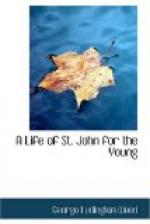As Jesus stood by the three recumbent forms held by deep sleep, and gazed by the pale moonlight into their faces which showed a troubled slumber, He knew they “were sleeping for sorrow.” In silence He looked upon them until His eye fastened—not on the beloved John—but on him who an hour ago had boasted of faithfulness to His Lord. The last utterance they had heard before being lost in slumber was that of agonizing prayer to the Father. The first that awakened them was sad and tender reproof—“Simon, sleepest thou? Couldest thou not watch one hour?” In the Master’s words and tones were mingled reproach and sympathy. In tenderness He added, “The spirit indeed is willing, but the flesh is weak.” Because of the spirit He pardoned the flesh. The question, “Why sleep ye?” was to the three, as well as the charge, “Rise and pray, that ye enter not into temptation.”
Let imagination fill out the outline drawn by the Evangelists:—“He went away again the second time and prayed; He came and found them asleep again; He left them and went away again and prayed the third time; and He cometh a third time and saith unto them, ’Sleep on now and take your rest.’” If we may suppose any period of rest, it was soon broken by the cry, “Arise, let us be going; behold he that betrayeth Me is at hand.” They need “watch” no longer. Their Lord’s threefold struggle was over. He was victor in Gethsemane, even as John beheld Him three years before, just after His threefold conflict in the wilderness.
As they rose from the ground the inner circle that had separated them, not only from the other Apostles but from all other men, was erased. We do not find them alone with their Lord again. They rose and joined the eight at the garden gate.
Recalling Gethsemane we sing to Jesus,
“Thyself the path of prayer hast trod.”
The most sacred path of prayer in all the world was in Gethsemane. It was only “a stone’s cast” in length. The Lord trod it six times in passing between the place where He said to the three, “tarry ye here,” and that where He “kneeled down and prayed.” One angel knows the spot. Would that he could reveal it unto us.
[Illustration: CHRIST BEFORE PILATE (Ecce Homo) H. Hofmann Page 182]
When Jesus was praying and the three were sleeping, Judas reported himself at the High-Priestly Palace, ready to be the guide of the band to arrest his Master. There were the Temple-guard with their staves, and soldiers with their swords, and members of the Sanhedrin, ready to aid in carrying out the plot arranged with the betrayer. It was midnight—fit hour for their deed of darkness. The full moon shone brightly in the clear atmosphere; yet they bore torches and lamps upon poles, to light up any dark ravine or shaded nook in which they imagined Jesus might be hiding. If any cord of love had ever bound Judas to his Master, it was broken. That very night he had fled from the Upper Room, which became especially radiant with love after his departure. To that room we believe he returned with his murdering band. But the closing hymn had been sung, and the Passover lamps extinguished two or three hours before. The consecrated place was not to be profaned with murderous intent. Another place must be sought for the victim of hate and destruction.




